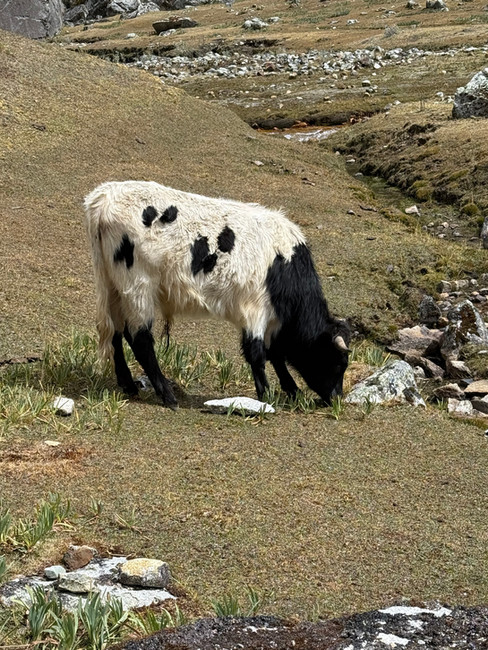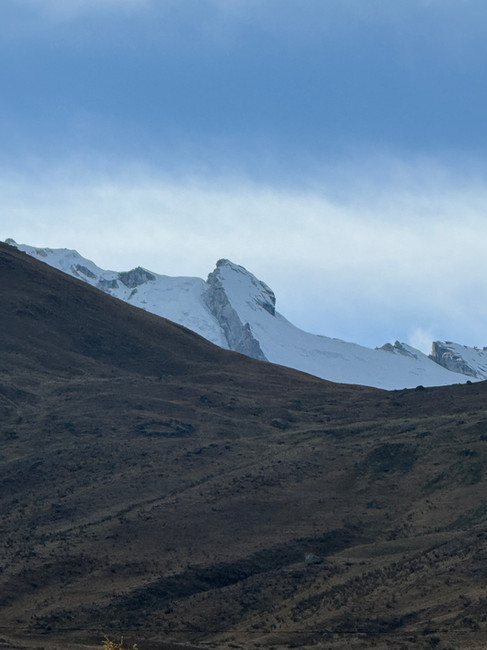Acclimatization for the 7-day trek in the Cordillera Huayhuash
- wdoerig
- Sep 6
- 7 min read
We planned two days for acclimatization in advance.
We arrive in Huaraz at 6:00 PM. We have an aperitif and a light bite to eat before falling into bed, sleep-deprived from the long journey.
The next day, we plan to do a 10-km round trip hike from Shilla to an elevation of 3,600 m. We decide to start late so that after our hike, we can visit the pizzeria in the village, which doesn't open until 3:00 p.m., without having to wait.
9:00 a.m. breakfast, 10:00 a.m. departure, 1.5 hours drive. Through winding alleys and streets, we head through Huaraz down to the main road heading north.
Christina once again takes care of the bag we left behind in São Paulo, without which we can't start the trek. We're told that the bag will arrive in Lima today, Saturday, and will be delivered to the hotel in Huaraz on Sunday. To be on the safe side, we postpone the trek by one day.
An hour after starting, we turn right and drive up to Shilla on a surprisingly well-paved road.
The small fields we know from previous trips, steeply laid out and only cultivated by hand, open up to the left and right of the steep, upward-facing road.
We are happy to be back here and feel at home.
Arriving in Shilla, we park the car: the village is bustling with loud music. Women in traditional clothing mingle with young ladies in modern attire. It's Saturday.
We set off with our light backpacks
Mario Holenstein, the owner of our hotel, is guiding us. He sees the hike as a welcome change from the rigors of everyday life at his resort.
A little further down, cows grazing.
We wave to each other from afar. The people here are extremely friendly.
They are very interested in where we come from and where we are going; they often even shake hands when greeting each other on the way.
Dogs bark and follow us for short distances. A young male dog wants to play with us and doesn't leave our side during a rest stop.


The path quickly descends back to the village, just as steeply as before. We climb over ditches dug to irrigate the small fields.

Without the water flowing from the mountains, agriculture would be unthinkable here. Everything would wither during the dry season.
The farmers here lead a very hard, undemanding life. They extract every grain, every potato, from nature by hand. They provide for themselves with their fields and animals. They don't have enough for anything more.
Soon we reach the first very simple houses on the edge of the village. Pigs behind wooden sheds, tied by one leg, sheep, and cattle line our path to the village center near the church.
There's still an hour until 3:00 p.m. We visit the church and meet Italian pilgrims.
The area around Huaraz is dominated by the Italian Order of Don Bosco. Many huts in the high Andes were built by the order and are run by young believers. Churches were also built by Don Bosco and are run by priests from the order.
The pizzeria is also part of the order.

We're served by a religious family with their 8- and 10-year-old daughters. The pizza tastes delicious. We chat and are happy to have met such friendly people.

We drive to the hotel and lie down in bed, dead tired.
On Sunday, we want to get up early. A long hike awaits us, between 4,000 and 4,400 meters, to which Mario has invited us.
We set off at 6:30 a.m. Mario, in his 4x4, turns right shortly after we leave Huaraz heading north.
A bumpy, dusty road leads into the valley. The path narrows ever further, clinging to the steep, ancient moraine.
Driving errors here would lead to certain death, but Mario steers his vehicle confidently along the bumpy path as if driving in this dangerous terrain were his profession. The higher we climb, the more open the withered meadows become, and Mario finds a place to park his car.
We continue on foot towards the narrow valley, then deep into Laguna Shallap.
We are allowed to walk the entire path, as if on a carpet of very short, dry grass rolled out for us. Bushes and blossoms spread the scent of fresh honey into the new day.
The glacial river, with its rusty stones and orange-green-red water, seems bizarre and unfamiliar, although the colors are certainly pleasing to the eye. It's so beautiful, we're simply happy to be here.
The path continues on a very gentle incline through Polylepis forests further into the valley, where the forest thins out and meadows where cattle graze open up.
The colorful river is our constant companion. Thanks to it, the meadows are green and provide food for the animals.
Almost at the end of the valley, the path becomes steeper, climbing up to the wall that encloses the lagoon; far above, the glacier that feeds the lake with its meltwater.
It is important to learn how such lagoons were formed and why the glacial lakes were always secured with an artificial, man-made wall.
Glacial lakes formed where glaciers descended from the almost vertical to the valley floor in ancient times. The pressure of the ice and the friction created by the ice flow carved out depressions in the valley floor, which filled with meltwater as the glaciers retreated.
In the Cordillera Blanca, terrible tragedies have occurred in the past when large glaciers fell into such glacial lakes, causing them to overflow. The result was mudslides that claimed the lives of tens of thousands of people. Following the disasters, stone dams were painstakingly constructed by hand to prevent overflow and allow water to flow away in a controlled manner.
What a sight: the green shimmering water, in the background the black wall where the glacier once fell away, and above it the glacier cliff with its blue-white ice wall.

The shimmering green lagoon and the rusty stones must be caused by iron-rich water; in addition to iron, the lake will also contain significant amounts of sulfur and phosphorus. Thus, the outflowing river will not only water the meadows in the valley but also fertilize them.
We don't linger long; an icy downdraft from the glacier forces us to return quickly. Just a short distance below the wall, the wind dies down again, allowing us to hike back in glorious weather and ideal temperatures.
On the way back, the valley looks so different. I discover flowers and plants that I hadn't noticed on the way up, and I take plenty of time to take photos.
Because of the beauty and grace of this place, I have lost all sense of space and time and cannot believe it when we see the car approaching again from afar.
Another wonderful acclimatization tour with tremendous natural beauty comes to an end.
Everyone is happy about the beautiful day with the great variety and the wonderful pictures that we were able to enjoy up here.
After arriving at the hotel, we thought we'd lie down for a bit before heading off to dinner, but we were wrong. On the drive down into the valley, a huge excavator blocked our road; there was absolutely no way around it or a detour. And it was Sunday.
So we wait with other vehicles for half an hour, no, an hour. The excavator has spent over two hours calmly widening the road, removing embankments, and leveling the road, until the monster disappears into the bushes down to the stream.
Later we will experience further episodes from the practical side of road construction in Peru.
We're at the hotel, Mario immediately starts his kitchen duty, and Christina and I actually lie down.
By the way, the bag did not arrive in Huaraz as promised; according to the tracker in the bag, it is now in Lima.
Monday, we were actually on our way to the Huayhuash trek, but we are still missing the big yellow expedition bag.
Unfortunately, we've completely lost trust in the local airline staff due to delays and misinformation. Again, they say the luggage will be delivered to the hotel today.
At breakfast, we can see on the tracker that the expedition bag is moving around Lima. No risk, Christina takes a taxi to Huaraz Airport to pick up the bag directly from the landing flight from Lima. With some organizational difficulties, she manages to free the bag from the airline's clutches thanks to the small size of the airport and is happy to finally have her luggage back after the long, anxious wait.
In the afternoon we go on a short hike directly from the hotel.
It's difficult to find the start of the circular route without a map. In the midday heat, I lead us too far to the right, following our noses; we follow small paths laid out for cultivating the typical, steep, small fields, continuing on the increasingly narrow paths.
"We're heading in the right direction, we're just too far to the right," I tell Christina. We're debating whether to turn around. My head won't let me; I want to go up there. Christina joins in. We walk through waist-high grass, which drops its burdock seeds on us and pricks our pants and socks.
Again and again, I find a way up to the ridge surrounding Huaraz. I go ahead, try to get through, and only catch up with Christina when I'm sure we can continue.
Often the best way through is along waterways; there is usually a small path running parallel to it that is used to reach branches where the water is diverted in other directions by damming.
A freshly burned patch of forest is particularly troubling for Christina: soot on her trousers and in her shoes is completely unacceptable to her.
Now the nonverbal point has come where the decision to go forward or back is on a knife edge, but Christina goes along with it.
Soon, after passing through a eucalyptus forest, we reach a herd of cows, accompanied by a dog and a shepherd. With hand signals, the shepherd shows me the way up to the ridge.

We can hardly believe that this is the way to go, but we trust the local farmer and, after searching, we actually find the way through the steppe up to the road that leads across the entire ridge to a viewpoint above Huaraz with a huge cross.
Christina doesn't want to take any more risks, so we stay on the paved path until we reach the outskirts of Huaraz and make our way through the canyons of buildings to the hotel. Nevertheless, when the path led close to the cliffs, we often had a great view down below and far above the city.
At dinner, Christina says to me, "That was a cool hike today."





































































